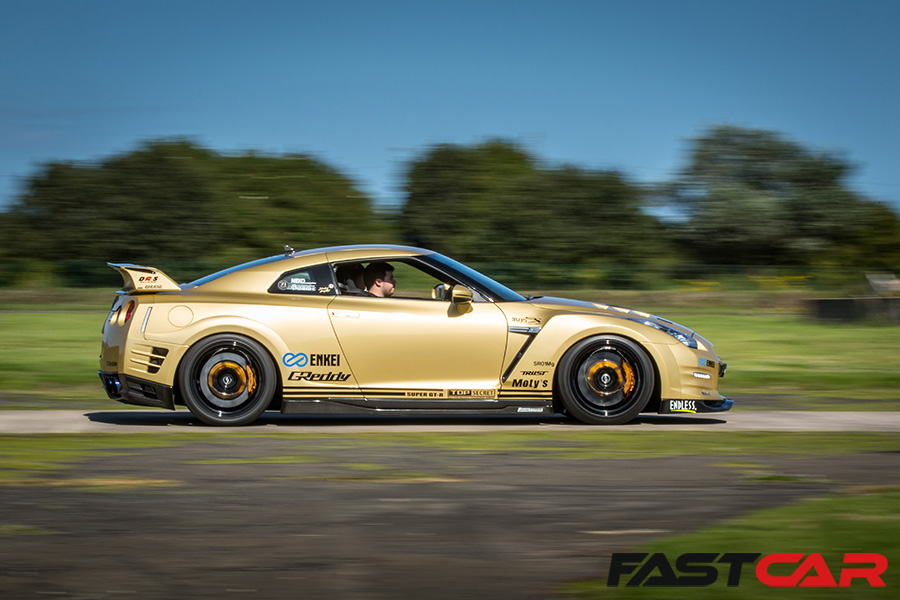Horsepower and torque are words that we’ve all heard before, but which one is more important to have in a car? Here’s the full lowdown…
So, what is horsepower, and what is torque? We all know that they’re things which make our cars faster, and we love tuning cars to achieve higher numbers. However, explaining exactly what horsepower and torque are can end up being a bit complicated. With that in mind, we’ve put together a definitive guide.
First up, let’s turn the tricky science into something basic. In the simplest terms, torque is the amount of turning force an engine has in one revolution. Power is the speed that an engine can move a certain weight, over a certain distance.
Due to a huge number of volumetric efficiency factors, the rpm where torque is the greatest varies depending on engine spec. Where power is the greatest varies too, as peak power is the point where the engine is spinning the fastest while still producing good torque.
What this means is that power is simply a combination of torque and rpm. Your engine has a certain amount of turning force (torque) per revolution, and it can turn with that force a certain number of times per minute, and that’s called power.
This is why cars with lots of torque at low rpm have good low-down performance. On the other hand, cars with fairly low torque figures – but which have the ability to rev very high – can feel similarly fast, just at the opposite end of the rev range. Simple, right?
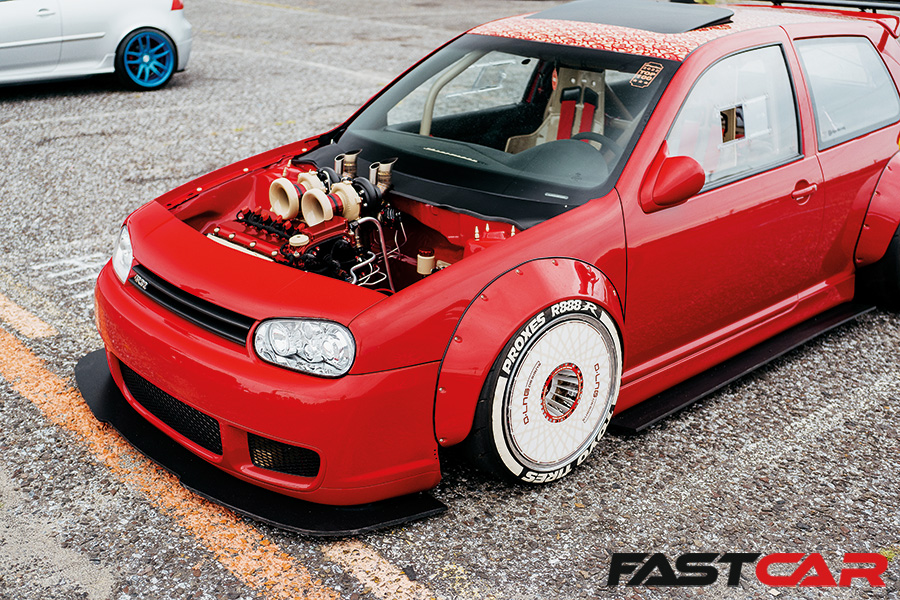
What makes cars fast? Power or torque?
Despite many drivers, especially V6 and diesel owners, parroting Carroll Shelby’s famous quote: “Horsepower sells cars, torque wins races”, it simply isn’t true. In fact, power is almost always the number one requirement.
For example, the Formula 1 V8 engines of the past had barely 220lb/ft of torque whereas a standard Mk5 Golf TDI has nearly 260lb/ft. But will a Golf TDI win a race against an F1 car? Don’t be silly. In fact, even if you gave it roughly a 100lb/ft torque advantage – say, against a Honda S2000 – it wouldn’t win that race either. So basically, no, torque doesn’t win races, power does.
That said, torque is still massively important.
If there are two cars, both with the same power but one with far more torque, the torque filled one will be faster, especially on twistier roads and tracks. And actually, if one car has a fraction more power, but much less torque, the torquey car will generally be faster despite the minor power deficit.
The importance of torque depends on the use of the car too. Flat-out racing where you’re constantly at high rpm means torque as most of us know it (i.e. low-down grunt) isn’t as important. But in situations where you aren’t always at high rpm, be it due to racing on twisty tracks or simply on a road car, big torque makes for a much, much faster car.

It’s ALL about the powerband
Peak numbers might be great for bragging rights, but in most situations they mean very little. What makes a car truly fast, and more to the point, fun, on road and track, is the spread of power and torque through the car’s rev range.
A good example of this is cars such as the aforementioned Honda S2000 and various Type R models. There is little doubt they are fast, indeed in a flat-out race they are around the same performance as any other car with a similar power to weight ratio. But overall, the small powerband makes them very hard work to drive to their true potential, especially on the road. To truly exploit the car’s performance you have to drop three gears from your usual cruising gear to go fast, so while you cruise at motorway speeds in sixth, you have to drop all the way down to third to accelerate hard. Things are the same in lower gears, where you need to drop to first below around 40mph to truly get the maximum performance from the engine.
On the flipside, most cars on the road spend much of their time at lower rpms. And where there’s a lot of tight bends that make it difficult to keep the revs high, modern turbo diesels (which while usually limited to under 5,000rpm, have got massive torque from around 1,500rpm) tend to be faster on the road than performance times would suggest.
It’s not only diesels though. Some petrol cars such as the Mk2 Focus ST are much the same, thanks to the big 2.5-litre engine spooling up the turbo so it pulls as hard from barely above idle as it does at the redline, making them very easy to drive quickly.
Small powerband vs big powerband
This issue of small powerband versus big powerband magnifies when tuning. Engine tuning can often raise and narrow a car’s powerband. And while swapping a small turbo for a big one may gain you 200bhp, you might end up with less lower RPM power than standard, and therefore be slower than standard up to 5,000rpm. In that scenario, you’d have to keep the revs up high if you wanted to use any of the power that you spent so much money on achieving.
Naturally aspirated engines are also affected by this, as fitting wilder cams and so on to an engine that’s already got a narrow powerband may make it so small it makes them almost unusable without a close ratio gearbox fitted. In fact, we’ve come across cars, both naturally aspirated and turbo, that due to the tiny powerband and poor gearing, totally drop out of the powerband every time you upshift, making for a car that has high peak power numbers, but is actually very very slow!
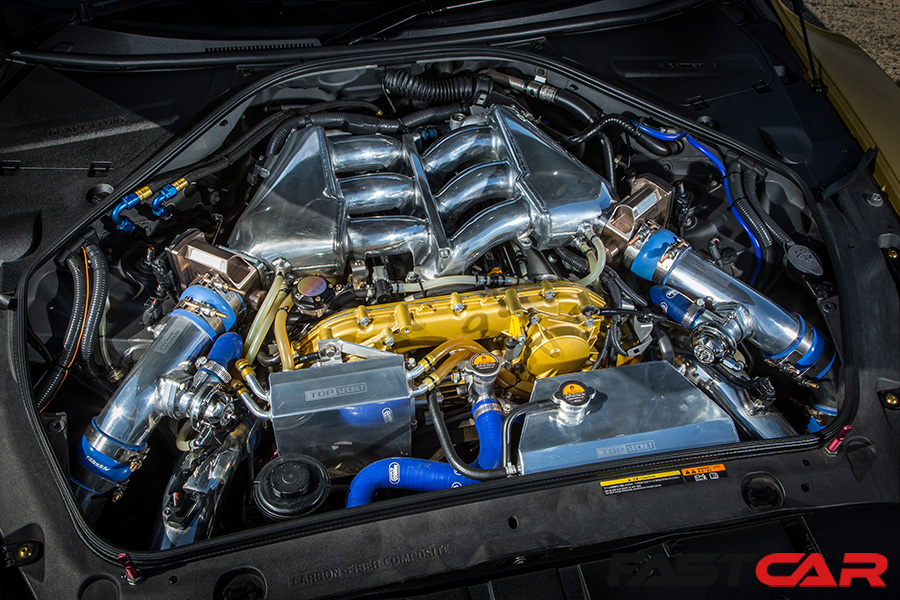
Having said that, if an engine has a tight powerband in its stock configuration, the usable rev range will actually widen if you add forced induction (whether it be turbos or a supercharger). In this instance, you’ll get greater power from whatever rpm the turbo kicks in, or indeed from idle on a supercharger. This totally transforms how the car drives, making it much easier to drive fast.
High powered cars
If you’re dealing with a car with huge power figures, something to keep an eye on is how progressive and smooth the power delivery is. While high rpm-only performance feature often with the craziest builds, cars going from no power to an absolute explosion of power in the space of 500rpm will suffer from traction issues, making it hard to drive on the limit.
Too much torque can create a similar issue. While a big chunk of torque at lower rpm makes for a fun car to drive, often it’s simply too much for the tires to handle, so it’s just wasted in wheelspin.
Forced induction
To avoid this problem, a centrifugal supercharger is usually cited as the solution. Unlike a turbo or a positive displacement supercharger, boost increases linearly with rpm. At low revs you get a small amount of boost, and this increases until full boost at the rev limiter. This maximizes the powerband and traction.
Providing you do have the grip to use it, can you really have an engine that has ridiculous amounts of power and torque right across the rev range? Well the answer is of course, yes, when you start with a big V8 or similar. But we can’t all have massive V8s, and despite the well known phrase “There’s no replacement for displacement”, there really is, and that’s boost!
While it takes a talented engine builder to create an engine to the correct spec, it’s amazing how much power and torque a small engine can make at both low and high rpm when it’s running a lot of boost. In fact it’s quite easy to make a turbo engine have more performance from around 3,000rpm to 7,000rpm-plus than a normally aspirated engine with over three times the capacity. An extreme example of this is the 2.0-litre FIA-spec turbo rallycross engine, which runs huge amounts of boost and has up to 700lb/ft of torque and similar amounts of power with the inlet restrictors removed. These make huge power from low rpm to high, and even the 8.4-litre Dodge Viper V10 only makes 600lb/ft, and not until nearly 5,000rpm. A top spec Rallycross engine will cost you over £60,000 though…
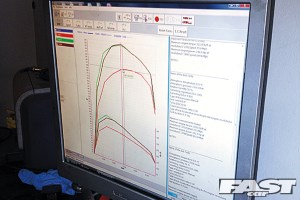
Dyno graph comparisons
One of the easiest ways to understand how a car will drive is to look at the dyno graph. This shows you where the performance is and, most importantly, where it isn’t. If you know what you’re looking at, these graphs make it very easy to see if a car has a small high rpm powerband, a torquey low rpm one, or anything in between. It’s also good for comparing different engines and modifications, and can be a massive eye-opener when you see how good, or sometimes how bad, certain engines can be.
What everything means on a dyno graph is pretty self explanatory, but relating it to the real world can sometimes confuse people. The easiest ways to look at it is maybe to ignore what line is power and what line is torque, and simply see how high the top lines are, and for how long. A car with a massive rev range will have a lot of torque at low rpm, and a lot of power at high rpm, so the top line of the graph will be high right across the rev range. And besides, when you’re driving you can’t feel the difference between power and torque as such anyhow, all you feel is how quickly you’re hurtling along!
Revving beyond peak power
A sudden increase in power or torque on a dyno graph is a good indication of where the main powerband starts, and where it begins to drop can usually indicate where it ends. However, it’s worth taking a good look at the numbers, as things can be deceiving. For example, where a car has 450lb/ft at 4,000rpm, but ‘only’ 250lb/ft at 3,000rpm, it might look on the graph like the performance is all 4,000rpm up. But the fact is, even 250lb/ft is a lot of torque, so the worthwhile powerband is far bigger than it might seem at first glance.
Peak power and torque issues are similar. Many think there’s no point revving beyond peak power. Some people even believe there’s no point revving beyond peak torque. But it’s always worth revving long beyond peak torque, and in many occasions beyond peak power too.
The reason is exactly the same as previously mentioned. That the car might make 500bhp at peak, but if it still makes 400bhp after that at even higher revs, it’s still very fast. In this case, it would be accelerating faster than it would be in the next gear up at a lower rpm.
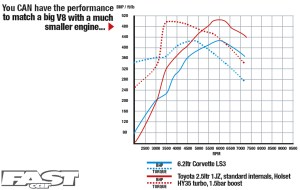
You CAN have the performance to match a big V8 with a much smaller engine…
We all know you make a small engine create much more power than a V8 engine by adding boost to it. But as long as you run a sensibly sized turbo and a lot of boost, you can actually even have as much or more low-to-mid-range grunt as well. And that’s something most people probably wouldn’t expect…
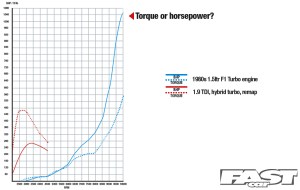
Torque or horsepower?
As an extreme example of how different engines behave, this comparison is the ultimate. One is a well modified 1.9TDI VW engine with a hybrid turbo pushing out very respectable performance; massive low rpm torque, but only revving to 4,500rpm.
The other is a 1.5-litre Formula 1 Turbo engine from the 1980s, which pushes out over 1,000bhp, 800bhp more than the diesel. But it has the low rpm performance of a typical 1.3-litre modern engine (i.e. very slow indeed).
There’s no doubt that above around 8,000rpm it’s insanely fast, in fact at its peak it’s more powerful than a Bugatti Veyron, but if installed in the same car, the 1.9TDI lump would easily out-drag it unless the driver kept the F1 Turbo lump spinning at 8,000rpm plus. The savage power delivery, with power jumping over 200bhp in the space of 500rpm at high rpm, means it’s only really suitable for high speed circuit and drag use on a car with huge amounts of grip.
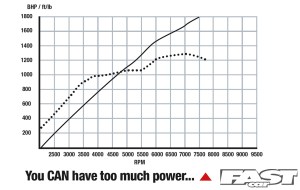
Can you have too much power?
As fun as ridiculous amounts of power sounds, aside from a drag car with giant slick tires and a perfect glued surface, engines really can make far more power than you can ever put down on the road.
With 450lb/ft anywhere beyond around idle speed, 1,000lb/ft of torque by just 4,000rpm, and well over 1,200lb/ft at high rpm, no matter what gear or speed you’re in, the tires will just turn to smoke with this engine. This is a dyno from a 7.0-litre twin turbo drag car, and there’s quite a few around with double this power…
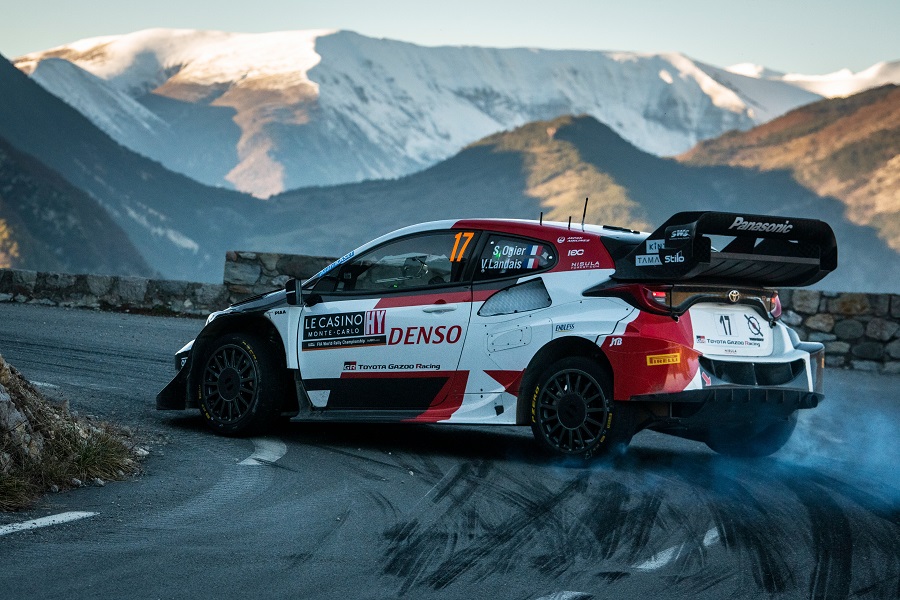
There’s more to fast acceleration than big power and torque
While having a lot of grunt is important, that’s not the only way to go fast. And in many cases there are lots of much cheaper ways too…
Lightness
Power to weight ratio is the key to performance, and it’s why cars like Caterhams and indeed many motorbikes, are supercar fast despite having less power than a lot of hot hatches. Conversely it’s why big busses and trucks are slow, despite having more power than most supercars. If your car can have a decent amount of weight removed from it, and you can live without the creature comforts, a lighter car is a faster car.
One thing that’s especially noticeable with a lighter car is that a lack of low rpm torque becomes less of an issue, as when there’s less weight to lug around, less grunt is needed to get the car moving quickly.
Gearing
Standard road car gear ratios tend to be a compromise between performance and fuel economy, and depending on what you use the car for and the type of powerband your engine has, you can drastically improve your acceleration without touching your engine spec. All you’d have to do is change the gear and diff ratios.
On rear-wheel drive cars, the easy thing to do is change a car’s diff for one from another model with a shorter gear ratio. Often a straight swap, you can drastically improve acceleration, albeit potentially at the cost of a marginally lower top speed.
The other gearing option, while often not as cheap, is adjusting the gearbox’s individual gear ratios. This is a job for the professionals and tends to involve fitting a competition spec gearbox. But, with closer ratio gears you can give the car lightning fast acceleration, and it also makes it easier to keep engines with peaky powerbands in their optimal rev range. Many competition cars run a longer first gear (as most standard first gears are far too short for performance use), a standard ratio second gear, and closer ratio gears beyond that. The result is, again, a lower top speed, but a constant wave of hard acceleration in every gear.
Traction
Does your car have 100 percent traction under the hardest acceleration possible in every single gear? If not, you’d go faster if you had more grip. All-wheel drive production cars such as Evos and Imprezas often have 0-60mph times that are as much as two seconds faster than front and even rear drive cars with the same power. Why? They’ve got the grip to use every last bit of it.
You don’t have to have all-wheel drive to get better grip though. The difference that a set of wide sticky track tires or an LSD can make to traction can be transformative.
Want to learn more about horsepower?
Check out some of our other features relating to horsepower:

What is Horsepower?
Have you ever wondered what horsepower really means? And why it’s so crucial when it comes to performance cars? Get ready to explore its impact on the world of modified cars.

What is Engine Torque?
Ready to explore the concept of engine torque and what it means for performance car tuning? Let’s dive in…

Types of Horsepower Explained
How much horsepower has your car got? Well, that depends on what units you’re using and how it was measured. There are several different types of horsepower figures, and they all mean something slightly different. Read on to learn more…

10 Things You Didn’t Know About Horsepower
Horsepower is the most common metric used to measure a car’s performance. But how much do you really know about it? Here are 10 facts that might surprise you.

